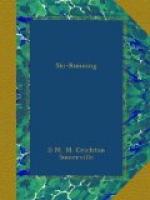Almost any wax can be ironed in, but I think the hard black “Skiolin” is best for the purpose. Be careful to wax the groove as well as the flat surface of the Ski.
When Skis are put away for the summer, the upper as well as the running surfaces should be oiled or re-varnished in order to preserve the wood.
Leather bindings may be well oiled with special boot oil to keep them supple.
Skis should never be kept in a hot place, as they are apt to warp, but they should be kept dry when put away.
Boots should never be dried by a fire or on a heater, but should be stored in a cool place. They need occasional oiling of the uppers with some sort of boot oil. Dubbin may also be used and is good for filling places, such as between the sole and the upper. The soles should never be oiled, except perhaps with Linseed oil, which hardens the leather. I think the wisest plan is to leave the soles dry, but if snow balls on them they can be waxed with Ski wax. This is often specially necessary on the heel. If boots be put outside the bedroom every night, the porter will oil them automatically, in most good hotels.
Sealskins should be wrapped up in newspaper and stored in a cool place when put away. Moth will ruin them if left open and heat crumples them, making them useless. A friend told me that when her seal Skis (webbing ones) were ruined by being put near a fire, she recovered them by soaking them in salad oil. She was certainly using them quite happily afterwards.
THE ELEMENTS OF SKI-ING
This book does not profess to be in any way a textbook of the technique of Ski-ing. As stated in the preface, my only idea in writing it is to provide an answer to a good many questions which have been asked me every year. Anyone who deals with a great many people knows that there are always some fifty stock questions, which can quite easily be answered by fifty stock answers. What I say in this chapter about the first run will be the barest elements of Ski running.
Beginners should obtain either Arnold Lunn’s books, or those of Vivien Caulfield, and concentrate on the theory of turns. I have known two or three novices who, though they had never even seen Skis before, by dint of studying the technique in theory before they came out, were able immediately to apply it in practice. Most beginners find, however, that the moment the Skis start sliding, all theory is thrown to the winds. Instinct of self-preservation prevails and they sit down. Kind friends looking on say, “That was because you were leaning backwards. You must lean forwards.” Off they start again, carry out the advice, their Skis stick for some reason and down they go head foremost—the most difficult fall of all to get up from, and the most aggravating.
The great thing is not to do too much the first two days after coming out. The height affects people more than they realize at first, and great energy, due to the bracing air, is often followed by great lassitude. Most people are not in training, and Ski-ing tries the lungs, nerves, and muscles of the fittest as the whole system seems to be brought into play.




